World's Largest Gypsum Dunefield, world record in White Sands National Park, New Mexico

White Sands National Park, New Mexico, United States--White Sands National Park, an American national park located in the state of New Mexico and completely surrounded by the White Sands Missile Range, covers 145,762 acres (227.8 sq mi; 589.9 km2) in the Tularosa Basin, including the southern 41% of a 275 sq mi (710 km2) field of white sand dunes composed of gypsum crystals; with a depth of about 30 feet (9.1 m), dunes as tall as 60 feet (18 m), and about 4.5 billion short tons (4.1 billion metric tons) of gypsum sand, the gypsum dunefield sets the world record for being the World's largest gypsum dunefield, according to the WORLD RECORD ACADEMY.
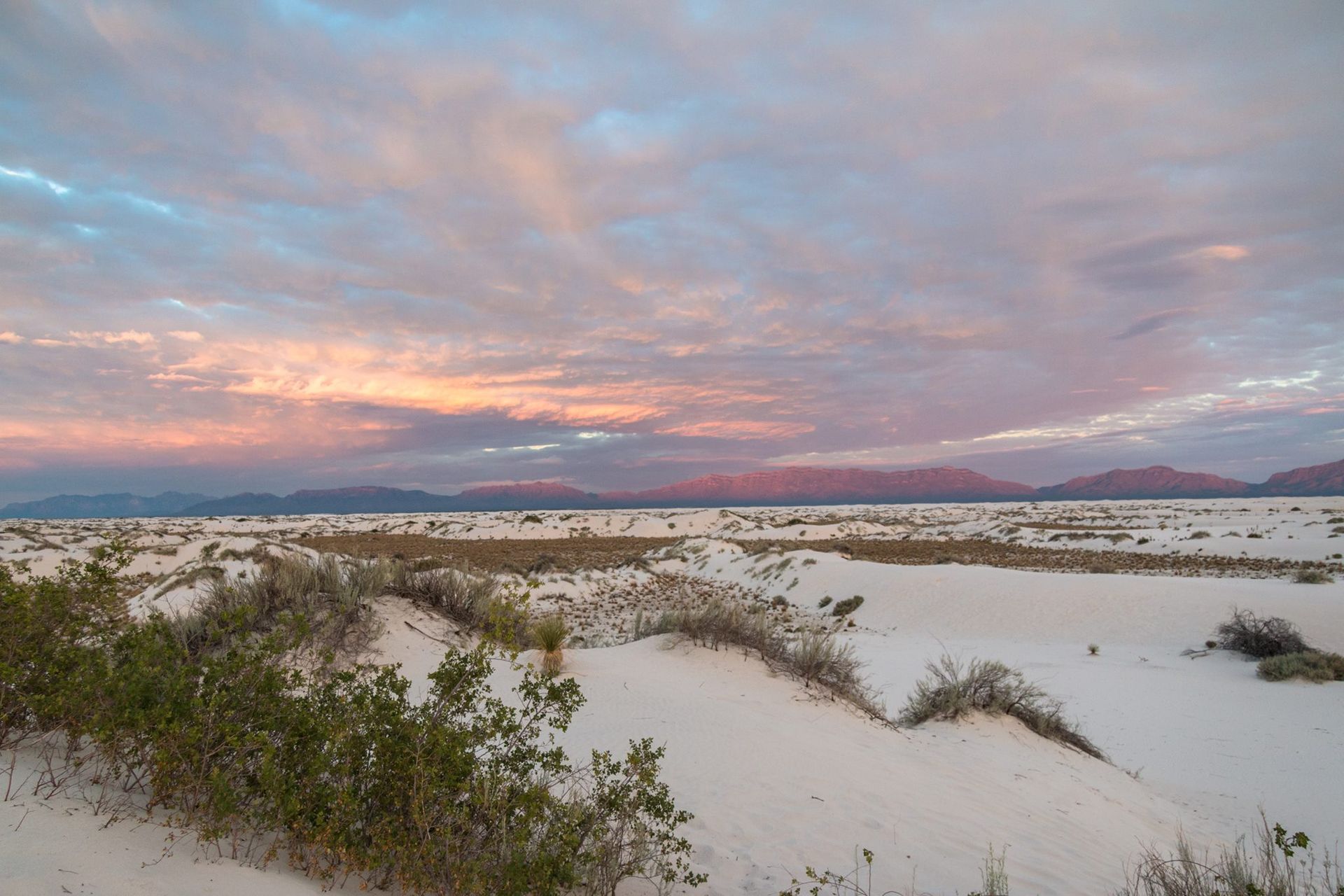
"The largest gypsum dune field in the world is located at White Sands National Monument in south-central New Mexico. This region of glistening white dunes is in the northern end of the Chihuahuan Desert within an "internally drained valley" called the Tularosa Basin," the New Mexico Tourism Department says.
"The monument ranges in elevation from 3890' to 4116' above sea level. There are approximately 275 total square miles of dune fields here, with 115 square miles (about 40%) located within White Sands National Monument. The remainder is on military land that is not open to the public. This dune field is very dynamic, with the most active dunes moving to the northeast at a rate of up to 30 feet per year, while the more stable areas of sand move very little.
"The pure gypsum (hydrous calcium sulfate) that forms these unusual dunes originates in the western portion of the monument from an ephemeral lake or playa with a very high mineral content. As the water evaporates (theoretically as much as 80" per year!), the minerals are left behind to form gypsum deposits that eventually are wind-transported to form these white sand dunes. Many species of plants and animals have developed very specialized means of surviving in this area of cold winters, hot summers, with very little surface water and highly mineralized ground water."
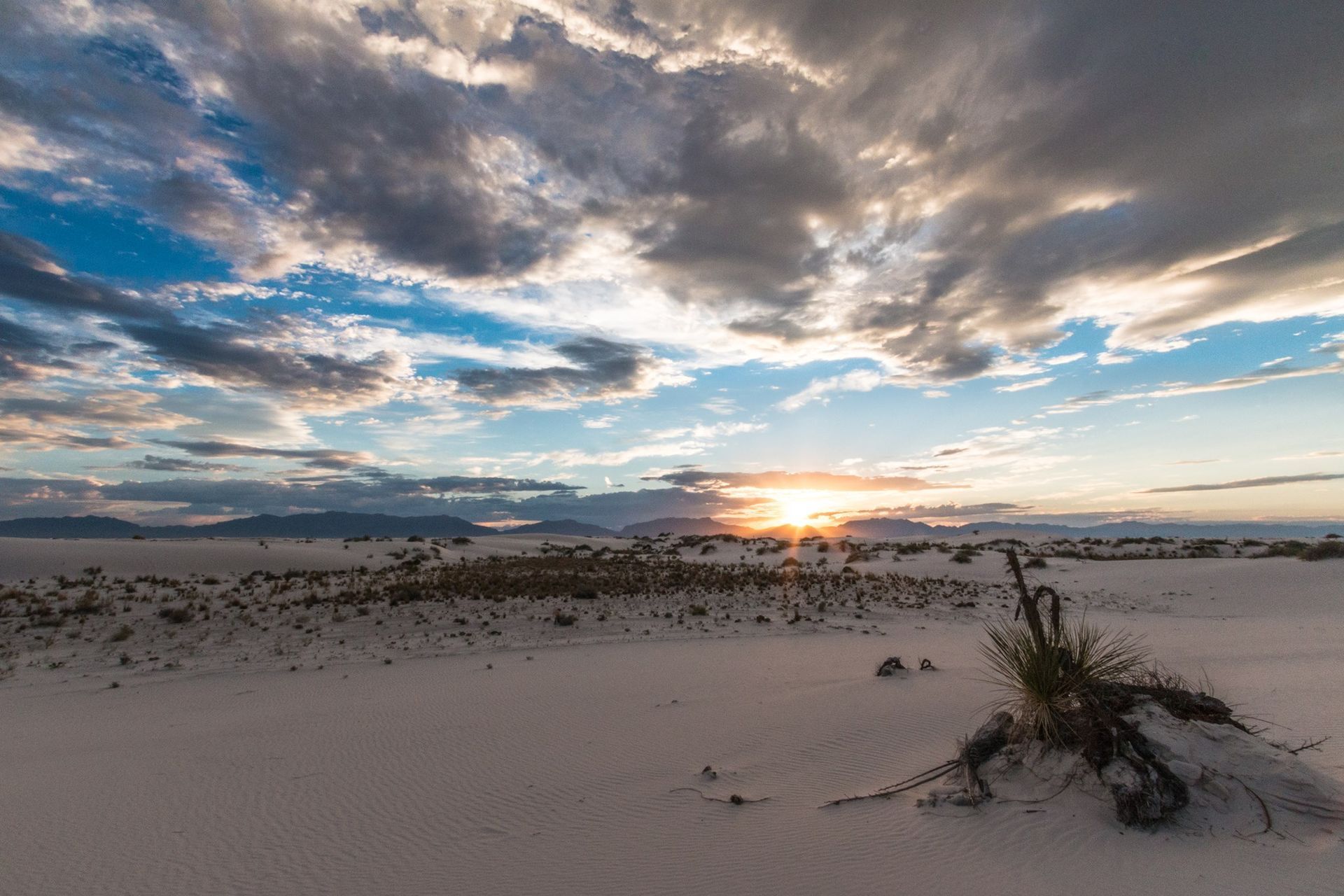
"The three largest gypsum dune fields in the world are located in the Chihuahuan Desert. White Sands National Park in New Mexico protects a portion of the largest dune field, the second largest field is located in Cuatro Cienegas in the Mexican state of Coahuila, and the third largest is in Guadalupe Mountains National Park in Texas" the
National Park Service says.
"It is unusual to find gypsum in the form of sand because it dissolves in water. Chihuahuan Desert dune fields are located in closed basins—meaning water does not flow out of the basins. Water sinks into the ground or forms shallow pools that dry out under the desert sun, leaving behind the gypsum crystals that break down into sand when exposed to the weather. Strong prevailing winds push the sand into dunes that constantly change shape as they move downwind. Vegetation and water stabilize the dunes."
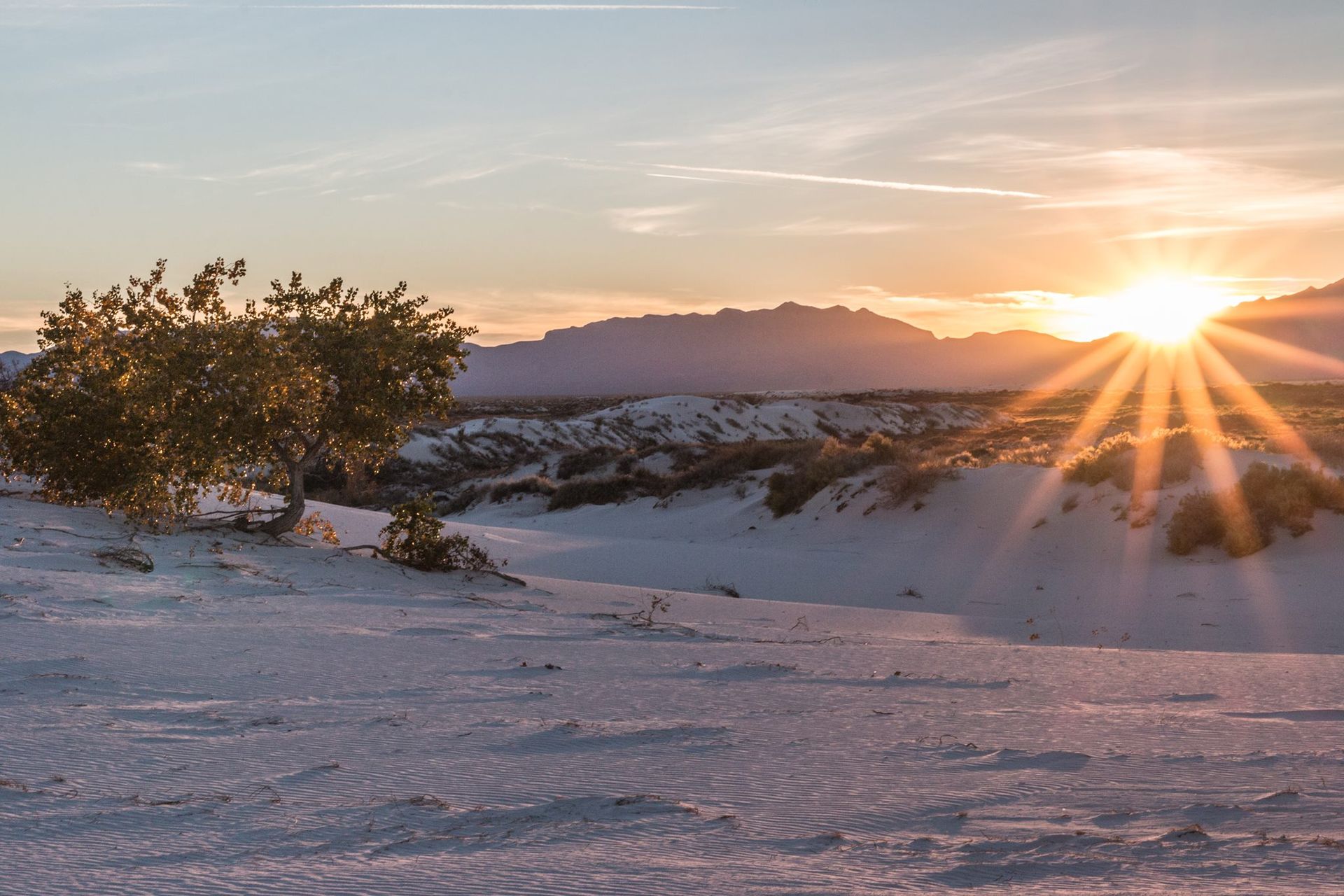
"In the heart of the Tularosa Basin is one of the world’s great natural wonders—glistening white sands. Great wave-like dunes of gypsum sand engulf 275 square miles of desert, creating the world’s largest gypsum dunefield. A major portion of this dunefield and its plants and animals are preserved," the Western National Parks Association says.
"Originally established as a national monument by President Hoover in 1933, White Sands National Park was re-designated as a national park on December 20, 2019. This glistening landscape preserves 275 square miles of gypsum dunes in the Chihuahuan Desert of southern New Mexico, making it the largest gypsum dunefield in the world. The story of these dazzling and shifting dunes began 280 million years ago when the Permian Sea covered the area and gypsum settled on the seafloor.
"A common mineral found all over the world, gypsum is rarely found in sand form, making the 275-square-mile dunefield a profoundly unique natural wonder. Learn more about the cultural, historical, and ecological significance of White Sands National Park and explore the unique recreational opportunities that make this park a one-of-a-kind experience for all visitors."

"The dunes appear bright white in the otherwise reddish-brown landscape. The light color is due to gypsum that was deposited in ancient Lake Otero, a water body that existed in the area when the climate was cooler and wetter. The gypsum originated from the nearby San Andres Mountains and first began washing into the basin close to the end of the last ice age, about 11,000 years ago. Today, the site is the largest gypsum dune field in the world," the
NASA Earth Observatory says.
"New deposits of gypsum are added to the sand dunes when mineral-rich waters from the surrounding mountains drain into the southwest margin of White Sands and subsequently evaporate to form gypsum crystals. Over the years, wind processes have eroded and shaped the dunes to reach about 60 feet (18 meters) tall.
"The White Sands region has a rich history in the aerospace industry. NASA utilized three runways built on the northern part of the lakebed for rocket testing and shuttle pilot training. The White Sands Space Harbor was used for one space shuttle landing when STS-3 returned from its eight-day mission to space. NASA continues to operate its White Sands Test Facility located just outside the bottom left of the photo."
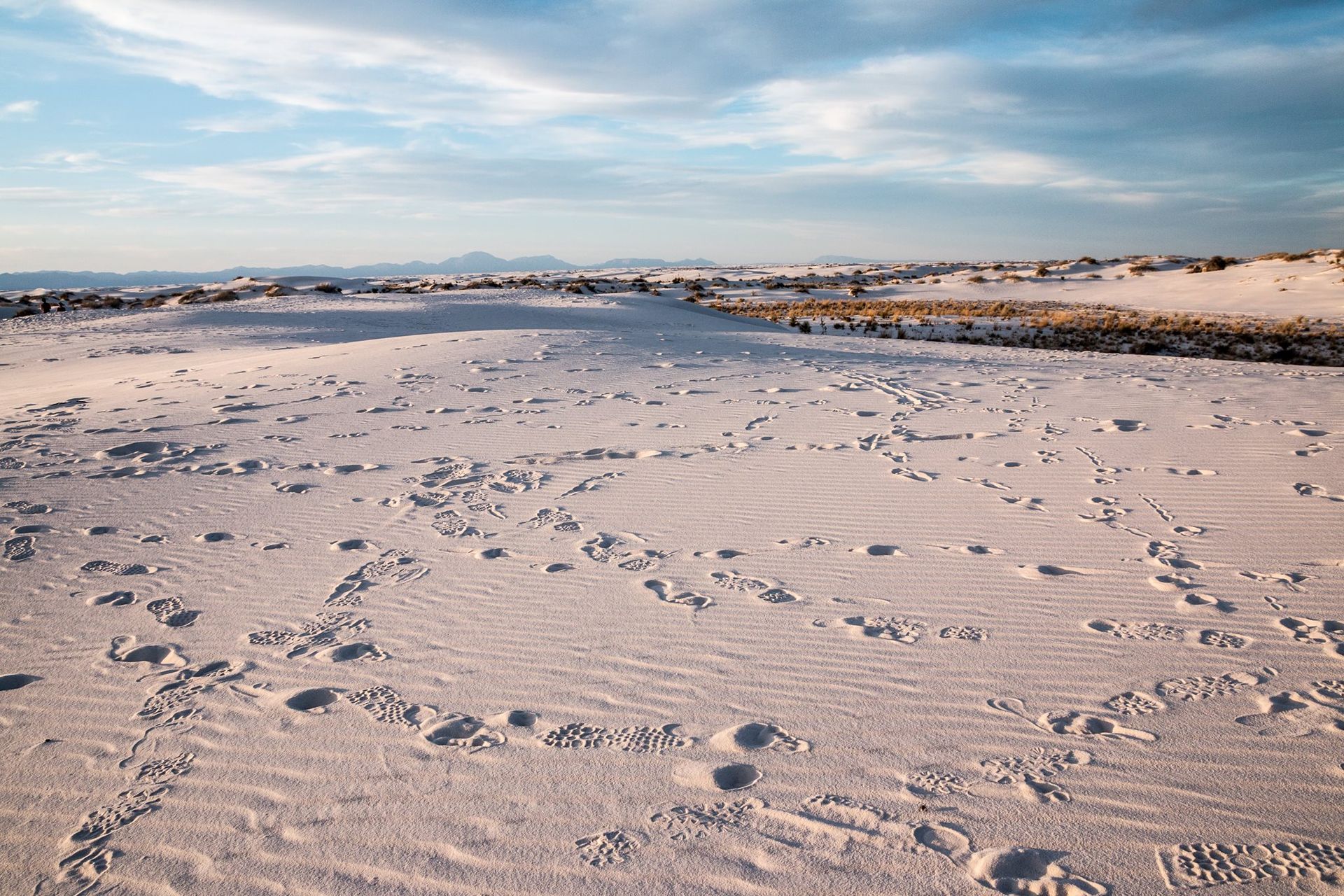
"Most of the New Mexico dunefield actually lies outside the boundaries of the park. White Sands National Monument is dwarfed by the White Sands Missile Range, a military testing area for the U.S. Army, and most of the dunefield lies within that missile range. The world's first atomic bomb was detonated at the Trinity test site in the missile range, just 65 miles north of this park, on July 16, 1945. Several weeks later, the U.S. dropped atomic bombs on Hiroshima and Nagasaki," the NPR says.
"They're not exactly the "only" white gypsum sand dunes in the world, but pretty close. The New Mexico dunes cover a vast area: 275 square miles. The next biggest gypsum dunefield is in Guadalupe Mountains National Park in Texas. Total dunefield area: about 3 square miles.
"The dunes are made of the soft mineral gypsum, laid down 250 million years ago when the southwestern U.S. was covered by the Permian Sea. Later, that seabed was pushed up into the mountains that ring the basin that surrounds the area. Rainfall dissolves those deposits, carrying the gypsum down and replenishing these sand dunes, which shift constantly with the winds."

"White Sands National Park is an American national park located in the state of New Mexico and completely surrounded by the White Sands Missile Range. The park covers 145,762 acres (227.8 sq mi; 589.9 km2) in the Tularosa Basin, including the southern 41% of a 275 sq mi (710 km2) field of white sand dunes composed of gypsum crystals. This gypsum dunefield is the largest of its kind on Earth, with a depth of about 30 feet (9.1 m), dunes as tall as 60 feet (18 m), and about 4.5 billion short tons (4.1 billion metric tons) of gypsum sand.
"Approximately 12,000 years ago, the land within the Tularosa Basin featured large lakes, streams, grasslands, and Ice Age mammals. As the climate warmed, rain and snowmelt dissolved gypsum from the surrounding mountains and carried it into the basin. Further warming and drying caused the lakes to evaporate and form selenite crystals. Strong winds then broke up crystals and transported them eastward. A similar process continues to produce gypsum sand today.
"Thousands of species of animal inhabit the park, a large portion of which are invertebrates. Several animal species feature a white or off-white coloration. At least 45 species are endemic, living only in this park, with 40 of them being moth species. The Tularosa Basin has also seen a number of human inhabitants, from Paleo-Indians 12,000 years ago to modern farmers, ranchers, and miners." (Wikipedia)
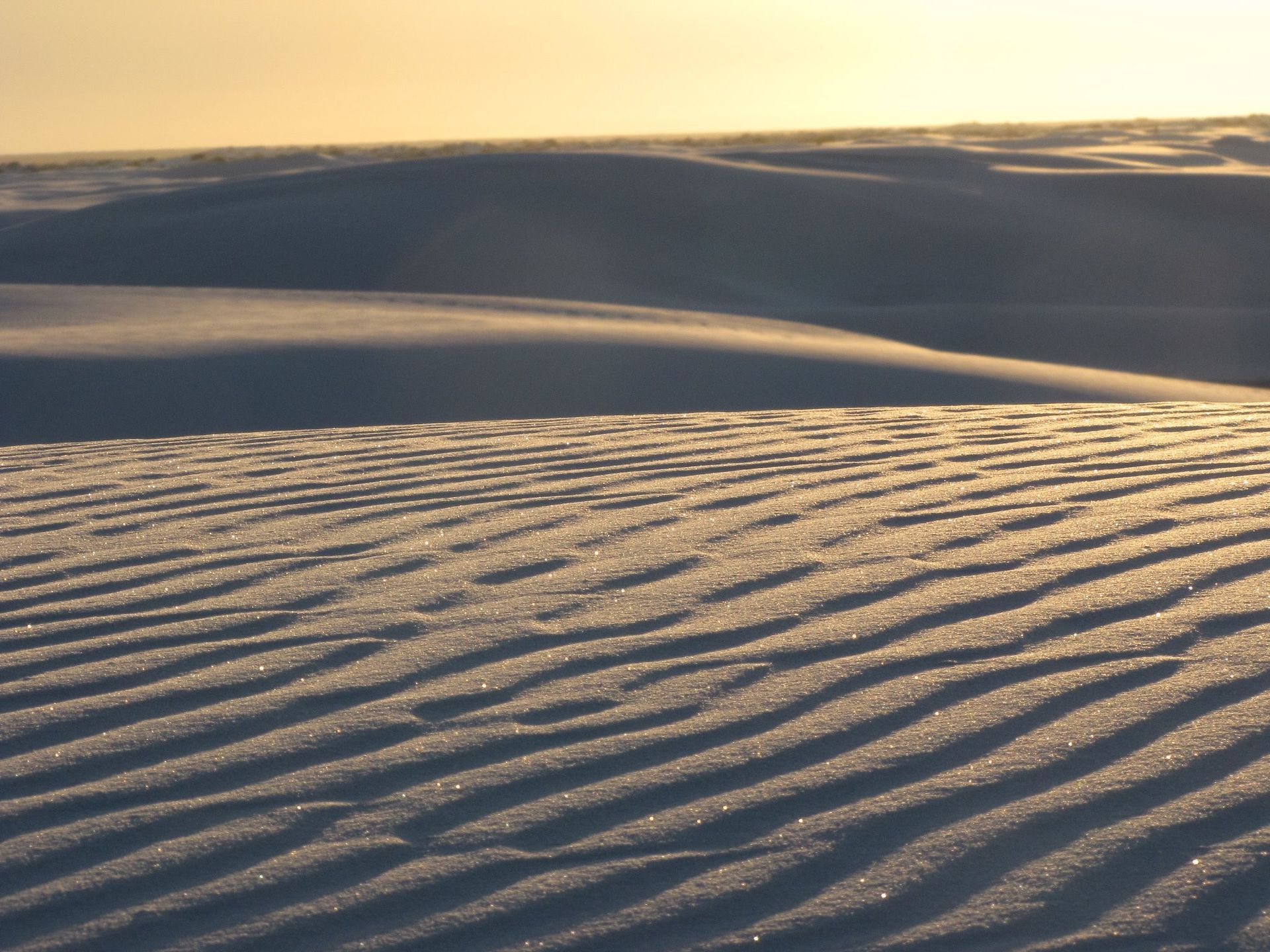
"Rising from the heart of the Tularosa Basin is one of the world's great natural wonders - the glistening white sands of New Mexico," the National Park Service says.
"Great wave-like dunes of gypsum sand have engulfed 275 square miles of desert, creating the world's largest gypsum dunefield. White Sands National Park preserves a major portion of this unique dunefield, along with the plants and animals that live here."
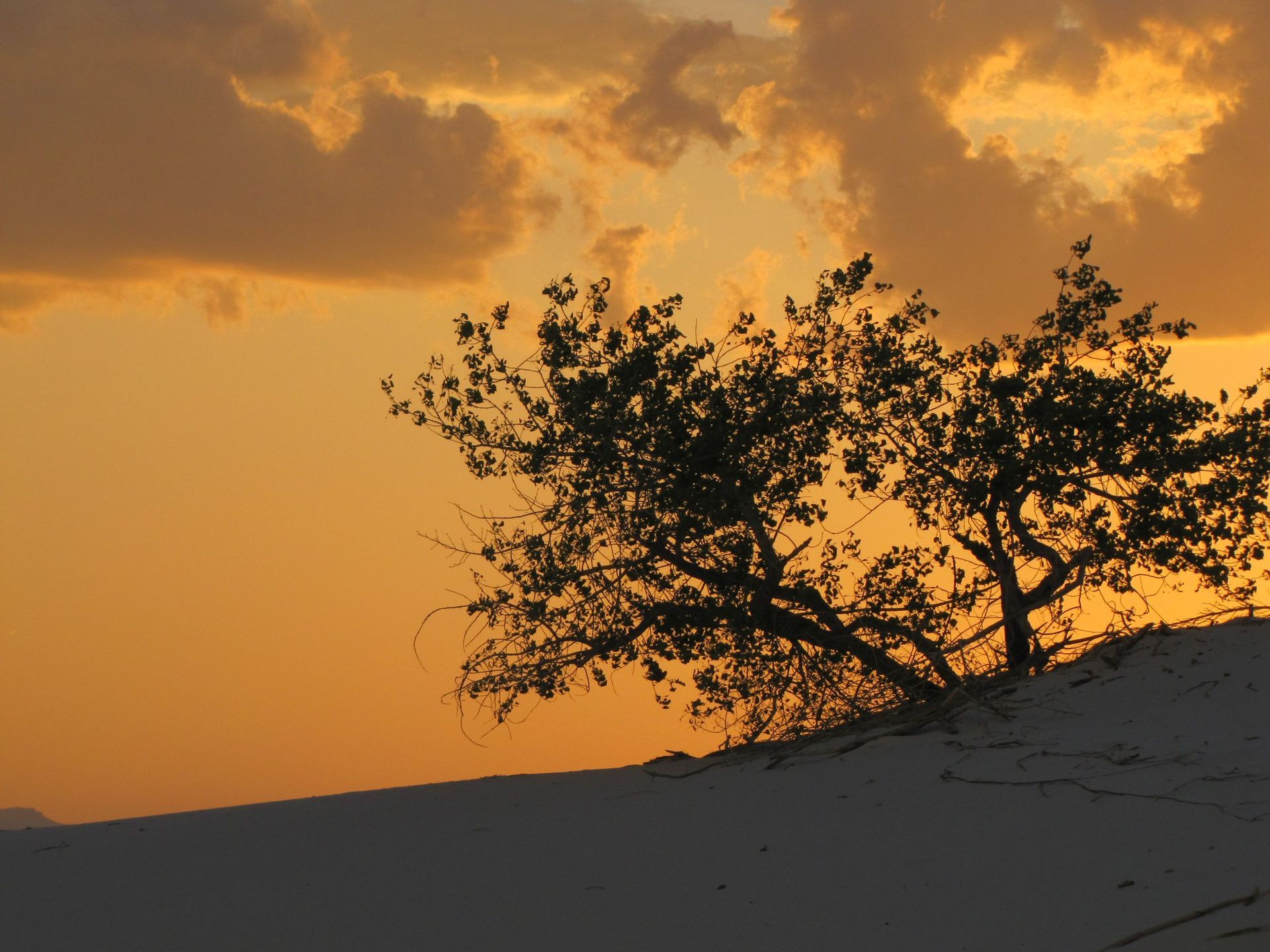
"The dunes, which are made of super-soft gypsum sand, sprawl for 275 square miles in south-central New Mexico, creating the world's largest gypsum dune field. In addition to their striking appearance, the gypsum sand dunes are extremely rare and house 800 animal species, including the park's endemic "white species" — mice, lizards, moths, and other insects that have gradually changed color, becoming lighter in color than their relatives elsewhere," the Travel + Leisure says.
"Visitors to White Sand National Park can hike on and sled down the giant mounds of powder-like sand. Popular hiking trails include Dune Life Nature Trail, a 1-mile loop that passes over two steep dunes, and the more strenuous Alkali Flat Trail, a 5-mile round-trip hike that goes up and down several dunes and passes by the final remnants of Lake Otero. (Don't let the word "flat" fool you.)
"For a truly unique experience, pick up a plastic sled at the White Sands Trading gift shop and sled down the sandy dunes, which feel like powder snow. And every month from April to October, the park hosts a guided full-moon hike that allows you to experience the eerie glow of the full moon reflecting on the white sand. You might even spot some of the park's nocturnal wildlife, like the kit fox, coyote, or desert cottontail who come out to hunt and forage when the sun sets and the sand cools."

"White Sands National Park rises from the heart of the Tularosa Basin and created the world's largest gypsum dune field. Here, great wave-like dunes of gypsum sand have engulfed 275 square miles of desert and preserves a piece of New Mexico's unique geology. Typically, gypsum is rarely found as sand because it dissolves in contact with water," the National Park Foundation says.
"But, the isolation and weather patterns of the Tularosa Basin creates a truly unique experience for intrepid park explorers. Visitors can hike (trails range from easy to extremely difficult, perfect for every-level of experience), partake in education ranger-led programs and even sled down the dunes in a few designation places.
"White Sands National Park preserves not only major portion of this unique dune field, but also the plants and animals that have successfully adapted to this constantly changing environment. White Sands was established as a national monument in 1933 and re-desginated as a national park in 2019. Today, its location between several military bases means the monument is sometimes closed due to missile tests. Visitors are always encouraged to check before making the trek."
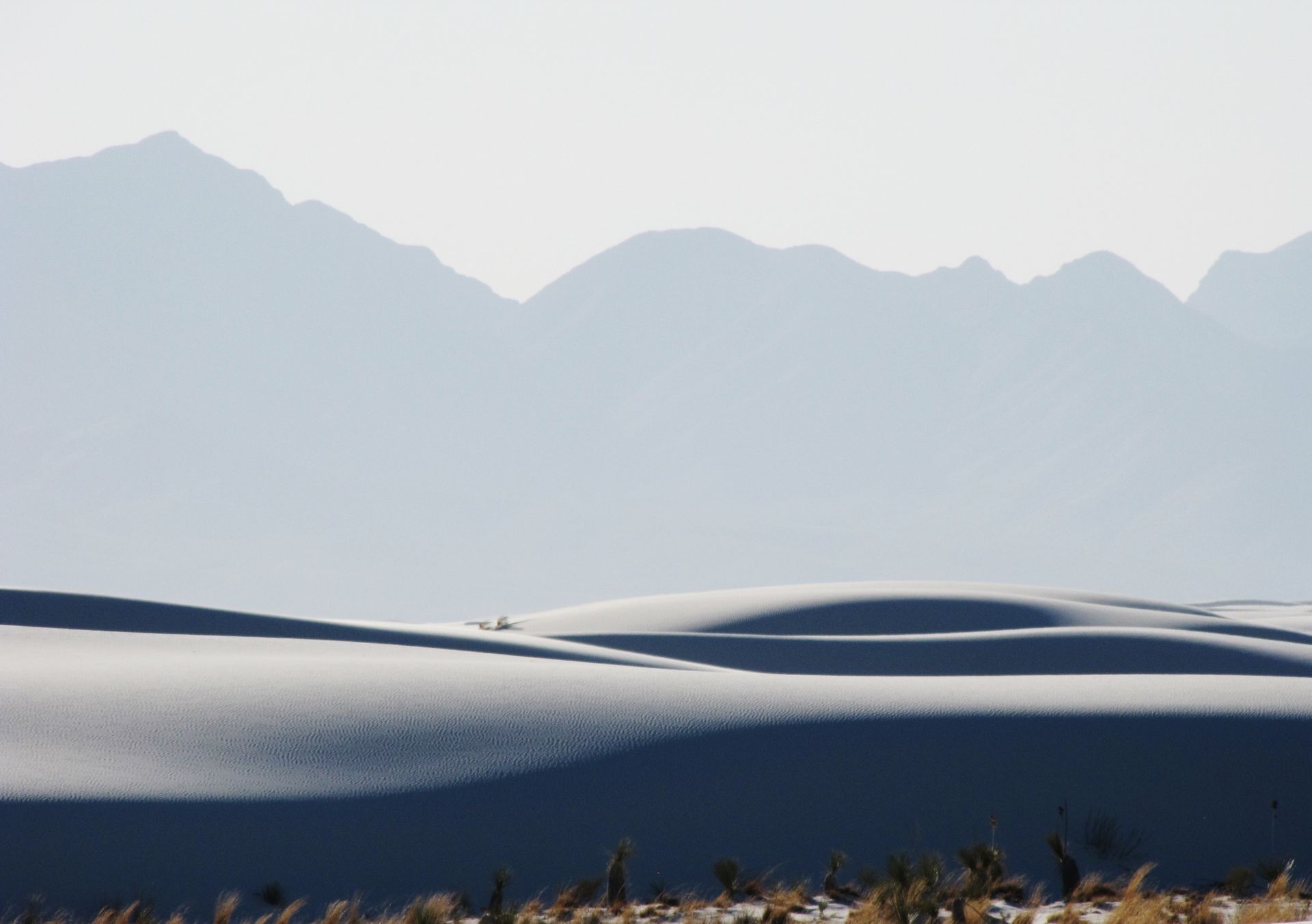
"Rising from the heart of the Tularosa Basin is one of the world's great natural wonders - the glistening white sands of New Mexico," the Visit Albuquerque says.
"Great wave-like dunes of gypsum sand have engulfed 275 square miles of desert, creating the world's largest gypsum dunefield. White Sands National Park preserves a major portion of this unique dunefield, along with the plants and animals that live here."
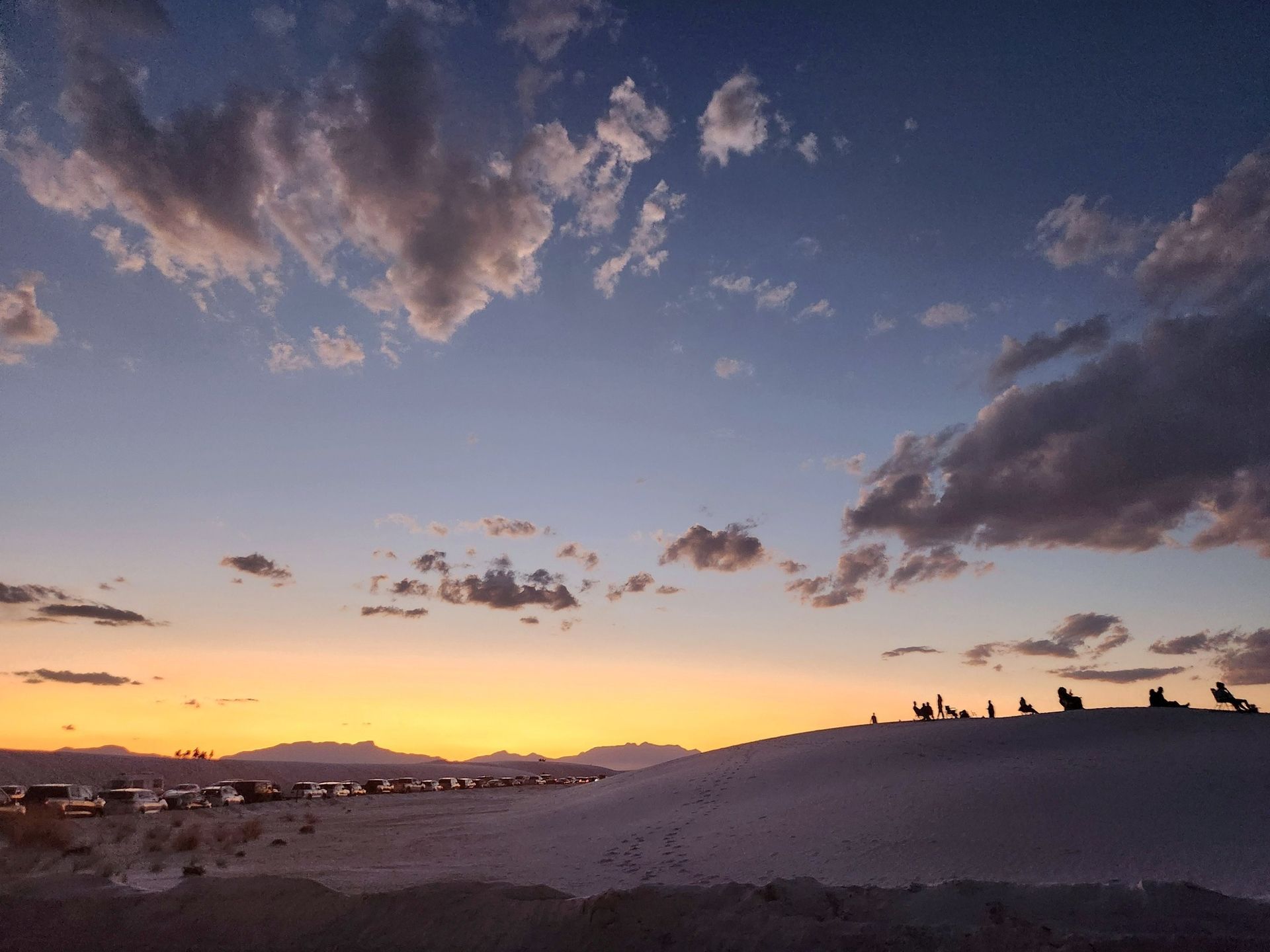
"The “sand” in these miles of shifting dunes is not composed of silica, like most inland sand. Interestingly, the sand at White Sands is almost pure gypsum. Gypsum is different from many other rocks because it is readily soluble. That means it will dissolve in water, just like sugar or salt. When rain falls on the mountains, the layers of gypsum start to dissolve, and the gypsum runs down the mountains as fast as the water can carry it," the Visit Las Cruces says.
"Gypsum is actually a clear substance; the dunes appear white like snow because the gypsum grains are constantly banging into each other. The scratches then reflect the sun’s rays making them appear white. Also, unlike silica sand, gypsum doesn’t absorb heat from the sun. So even on the hottest day of the year, the dunes are cool and comfortable to walk on, making White Sands a nice stop in the summer. Just visit when the sunrays are not at their peak, and remember to bring plenty of water to drink.
"The Dunes Drive, an eight-mile scenic roadway through White Sands, which leads from the visitor center into the heart of the dune field, is an otherworldly ride. Allow 30-minutes driving time for this 16-mile round trip, plus additional time for hiking, photography, sand play and other recreational activities. Moonlight hikes and sunset tours are available throughout the year from the visitor center, so visitors can get a whole new perspective as the light changes."
Related world records:
World's Highest Hill: world record near Poteau, Oklahoma
World’s largest artificial reef: world record off Grand Isle, Louisiana
World's Longest Cave System: world record in Edmonson County, Kentucky
World's Largest Exposed Granite Outcrop: world record in Stone Mountain, Georgia
World's Largest Pallasite Meteorite: world record in Greensburg, Kansas
World’s Largest Cannonball Concretions: world record in Rock City, Kansas
World's Largest Geode: world record in Put-In-Bay, Ohio
World's Largest Alpine Valley: The San Luis Valley in Colorado sets world record
World's Largest Flat Topped Mountain: world record in Grand Junction, Colorado
World's Largest Glacial Pothole: Archbald, PA, sets world record

